Travel and Tourism Sector Report: Business Analysis and Impacts
VerifiedAdded on 2020/02/12
|16
|4718
|140
Report
AI Summary
This report provides a comprehensive analysis of the travel and tourism sector, examining its historical developments, structure, and the influence of various factors. The report delves into the key aspects of the industry, including the role of government, sponsored bodies, and international agencies. It also explores the impact of national and local economic policies on the success of the tourism sector. Furthermore, the report includes an analysis of the TUI group, one of the leading companies in the tourism industry, evaluating the factors affecting tourism demand, the strategies implemented to meet these demands, and the positive and negative economic, environmental, and social impacts of tourism, with specific reference to TUI. The report also discusses strategies to minimize negative impacts and maximize positive impacts, offering a detailed understanding of the travel and tourism sector and its multifaceted dynamics.
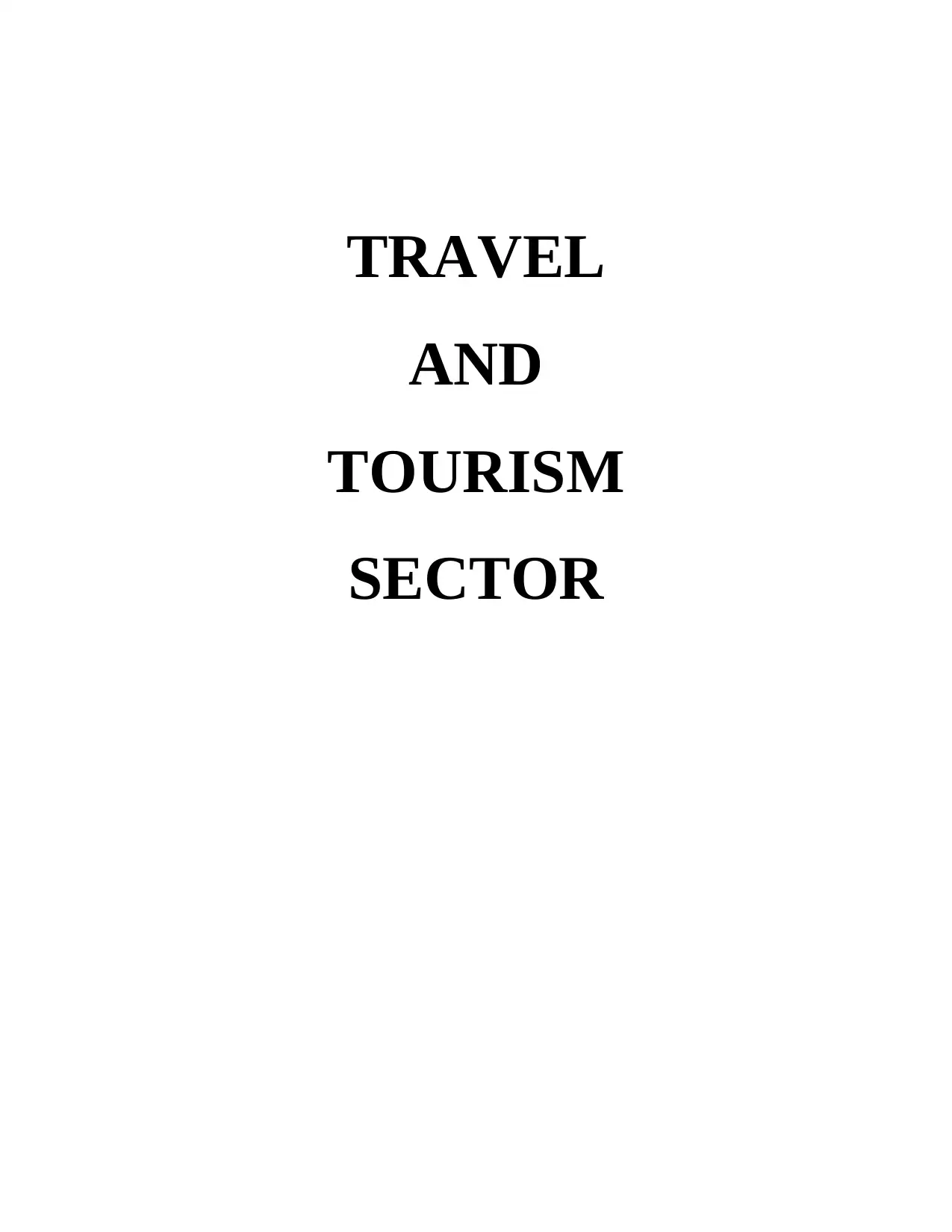
TRAVEL
AND
TOURISM
SECTOR
AND
TOURISM
SECTOR
Paraphrase This Document
Need a fresh take? Get an instant paraphrase of this document with our AI Paraphraser
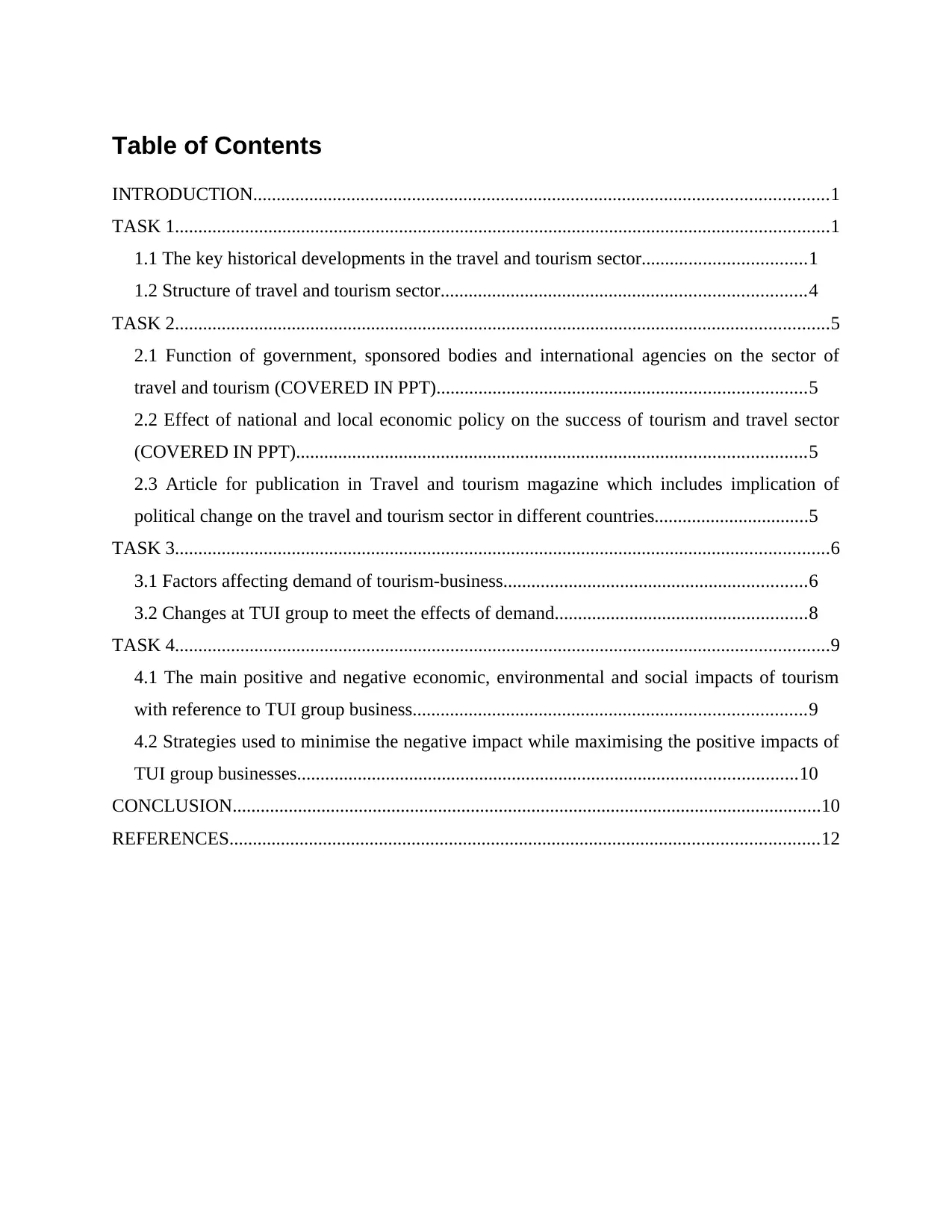
Table of Contents
INTRODUCTION...........................................................................................................................1
TASK 1............................................................................................................................................1
1.1 The key historical developments in the travel and tourism sector...................................1
1.2 Structure of travel and tourism sector..............................................................................4
TASK 2............................................................................................................................................5
2.1 Function of government, sponsored bodies and international agencies on the sector of
travel and tourism (COVERED IN PPT)...............................................................................5
2.2 Effect of national and local economic policy on the success of tourism and travel sector
(COVERED IN PPT).............................................................................................................5
2.3 Article for publication in Travel and tourism magazine which includes implication of
political change on the travel and tourism sector in different countries.................................5
TASK 3............................................................................................................................................6
3.1 Factors affecting demand of tourism-business.................................................................6
3.2 Changes at TUI group to meet the effects of demand......................................................8
TASK 4............................................................................................................................................9
4.1 The main positive and negative economic, environmental and social impacts of tourism
with reference to TUI group business....................................................................................9
4.2 Strategies used to minimise the negative impact while maximising the positive impacts of
TUI group businesses...........................................................................................................10
CONCLUSION..............................................................................................................................10
REFERENCES..............................................................................................................................12
INTRODUCTION...........................................................................................................................1
TASK 1............................................................................................................................................1
1.1 The key historical developments in the travel and tourism sector...................................1
1.2 Structure of travel and tourism sector..............................................................................4
TASK 2............................................................................................................................................5
2.1 Function of government, sponsored bodies and international agencies on the sector of
travel and tourism (COVERED IN PPT)...............................................................................5
2.2 Effect of national and local economic policy on the success of tourism and travel sector
(COVERED IN PPT).............................................................................................................5
2.3 Article for publication in Travel and tourism magazine which includes implication of
political change on the travel and tourism sector in different countries.................................5
TASK 3............................................................................................................................................6
3.1 Factors affecting demand of tourism-business.................................................................6
3.2 Changes at TUI group to meet the effects of demand......................................................8
TASK 4............................................................................................................................................9
4.1 The main positive and negative economic, environmental and social impacts of tourism
with reference to TUI group business....................................................................................9
4.2 Strategies used to minimise the negative impact while maximising the positive impacts of
TUI group businesses...........................................................................................................10
CONCLUSION..............................................................................................................................10
REFERENCES..............................................................................................................................12
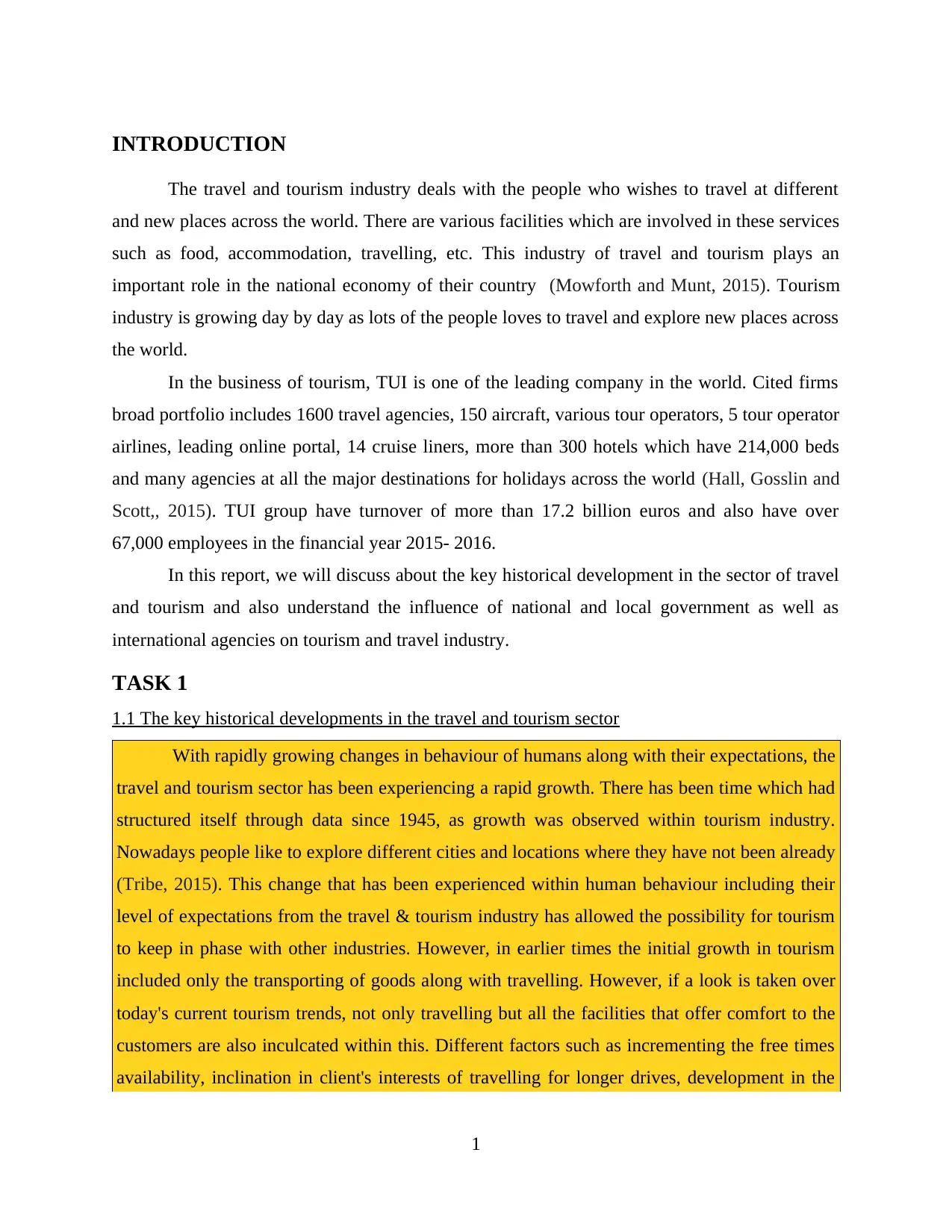
INTRODUCTION
The travel and tourism industry deals with the people who wishes to travel at different
and new places across the world. There are various facilities which are involved in these services
such as food, accommodation, travelling, etc. This industry of travel and tourism plays an
important role in the national economy of their country (Mowforth and Munt, 2015). Tourism
industry is growing day by day as lots of the people loves to travel and explore new places across
the world.
In the business of tourism, TUI is one of the leading company in the world. Cited firms
broad portfolio includes 1600 travel agencies, 150 aircraft, various tour operators, 5 tour operator
airlines, leading online portal, 14 cruise liners, more than 300 hotels which have 214,000 beds
and many agencies at all the major destinations for holidays across the world (Hall, Gosslin and
Scott,, 2015). TUI group have turnover of more than 17.2 billion euros and also have over
67,000 employees in the financial year 2015- 2016.
In this report, we will discuss about the key historical development in the sector of travel
and tourism and also understand the influence of national and local government as well as
international agencies on tourism and travel industry.
TASK 1
1.1 The key historical developments in the travel and tourism sector
With rapidly growing changes in behaviour of humans along with their expectations, the
travel and tourism sector has been experiencing a rapid growth. There has been time which had
structured itself through data since 1945, as growth was observed within tourism industry.
Nowadays people like to explore different cities and locations where they have not been already
(Tribe, 2015). This change that has been experienced within human behaviour including their
level of expectations from the travel & tourism industry has allowed the possibility for tourism
to keep in phase with other industries. However, in earlier times the initial growth in tourism
included only the transporting of goods along with travelling. However, if a look is taken over
today's current tourism trends, not only travelling but all the facilities that offer comfort to the
customers are also inculcated within this. Different factors such as incrementing the free times
availability, inclination in client's interests of travelling for longer drives, development in the
1
The travel and tourism industry deals with the people who wishes to travel at different
and new places across the world. There are various facilities which are involved in these services
such as food, accommodation, travelling, etc. This industry of travel and tourism plays an
important role in the national economy of their country (Mowforth and Munt, 2015). Tourism
industry is growing day by day as lots of the people loves to travel and explore new places across
the world.
In the business of tourism, TUI is one of the leading company in the world. Cited firms
broad portfolio includes 1600 travel agencies, 150 aircraft, various tour operators, 5 tour operator
airlines, leading online portal, 14 cruise liners, more than 300 hotels which have 214,000 beds
and many agencies at all the major destinations for holidays across the world (Hall, Gosslin and
Scott,, 2015). TUI group have turnover of more than 17.2 billion euros and also have over
67,000 employees in the financial year 2015- 2016.
In this report, we will discuss about the key historical development in the sector of travel
and tourism and also understand the influence of national and local government as well as
international agencies on tourism and travel industry.
TASK 1
1.1 The key historical developments in the travel and tourism sector
With rapidly growing changes in behaviour of humans along with their expectations, the
travel and tourism sector has been experiencing a rapid growth. There has been time which had
structured itself through data since 1945, as growth was observed within tourism industry.
Nowadays people like to explore different cities and locations where they have not been already
(Tribe, 2015). This change that has been experienced within human behaviour including their
level of expectations from the travel & tourism industry has allowed the possibility for tourism
to keep in phase with other industries. However, in earlier times the initial growth in tourism
included only the transporting of goods along with travelling. However, if a look is taken over
today's current tourism trends, not only travelling but all the facilities that offer comfort to the
customers are also inculcated within this. Different factors such as incrementing the free times
availability, inclination in client's interests of travelling for longer drives, development in the
1
⊘ This is a preview!⊘
Do you want full access?
Subscribe today to unlock all pages.

Trusted by 1+ million students worldwide

per capital income of individuals residing in UK, enhancement of the tour packages that are
offered by various organizations till now, have come into notice since the year of 1960.
Considering the present times the travel and tourism formation has been highly effected
by the ample amount of growing industries within the same segment. The recently developed
corners within the same field are offering more attractive packages that too customer-oriented
for enhancement of business (Dillimono and Dickinson, 2015). The current business of travel
and tourism not just has inclusion of travel-services but all things in association with customers
are effectively managed. Based upon the diversification of tourism-business various sectors in
travel have been classified. These include, travel-services, tour-operations, hotel industry,
passports and visa preparations, conference & event conduction, clothes exploring along with
defined stock, etc.
2
offered by various organizations till now, have come into notice since the year of 1960.
Considering the present times the travel and tourism formation has been highly effected
by the ample amount of growing industries within the same segment. The recently developed
corners within the same field are offering more attractive packages that too customer-oriented
for enhancement of business (Dillimono and Dickinson, 2015). The current business of travel
and tourism not just has inclusion of travel-services but all things in association with customers
are effectively managed. Based upon the diversification of tourism-business various sectors in
travel have been classified. These include, travel-services, tour-operations, hotel industry,
passports and visa preparations, conference & event conduction, clothes exploring along with
defined stock, etc.
2
Paraphrase This Document
Need a fresh take? Get an instant paraphrase of this document with our AI Paraphraser
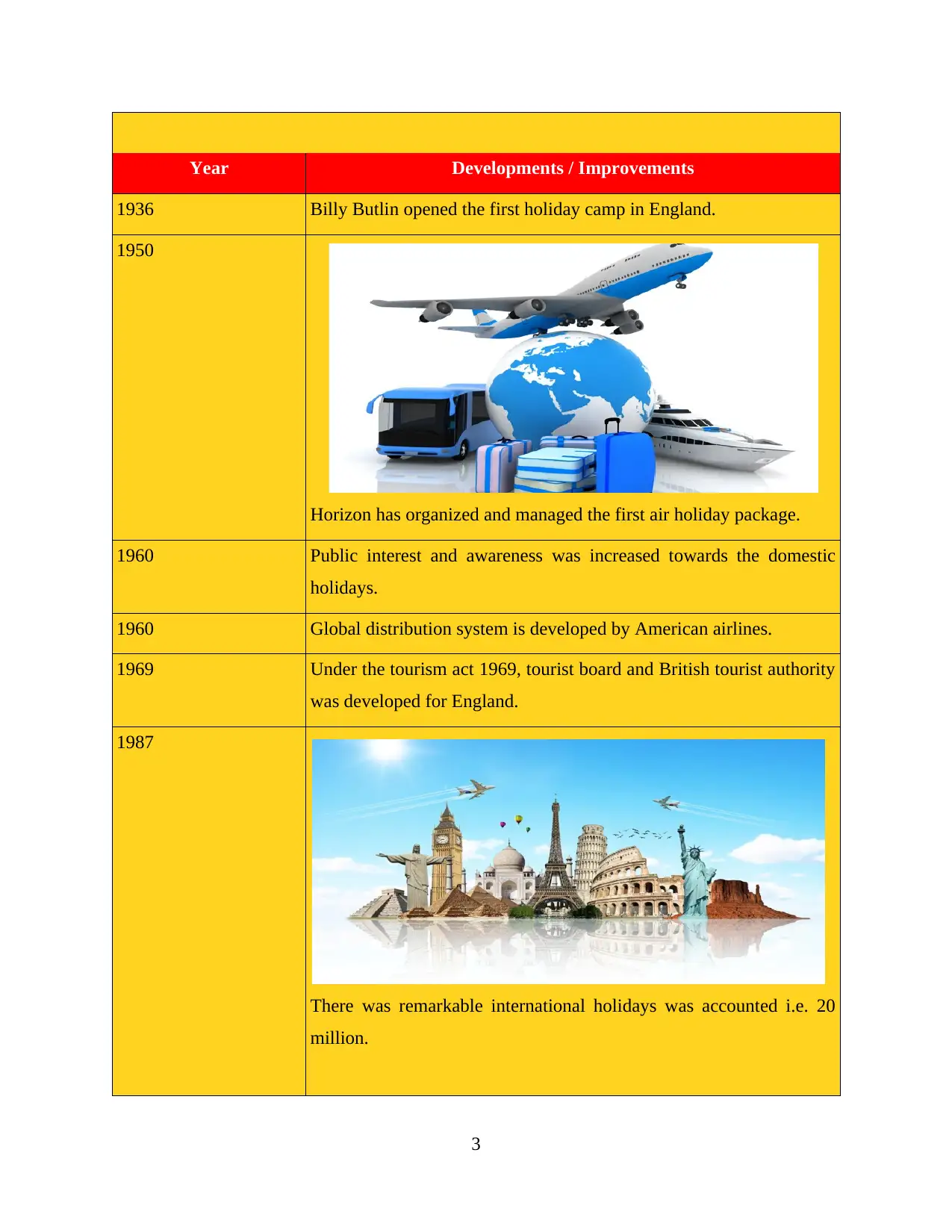
Year Developments / Improvements
1936 Billy Butlin opened the first holiday camp in England.
1950
Horizon has organized and managed the first air holiday package.
1960 Public interest and awareness was increased towards the domestic
holidays.
1960 Global distribution system is developed by American airlines.
1969 Under the tourism act 1969, tourist board and British tourist authority
was developed for England.
1987
There was remarkable international holidays was accounted i.e. 20
million.
3
1936 Billy Butlin opened the first holiday camp in England.
1950
Horizon has organized and managed the first air holiday package.
1960 Public interest and awareness was increased towards the domestic
holidays.
1960 Global distribution system is developed by American airlines.
1969 Under the tourism act 1969, tourist board and British tourist authority
was developed for England.
1987
There was remarkable international holidays was accounted i.e. 20
million.
3
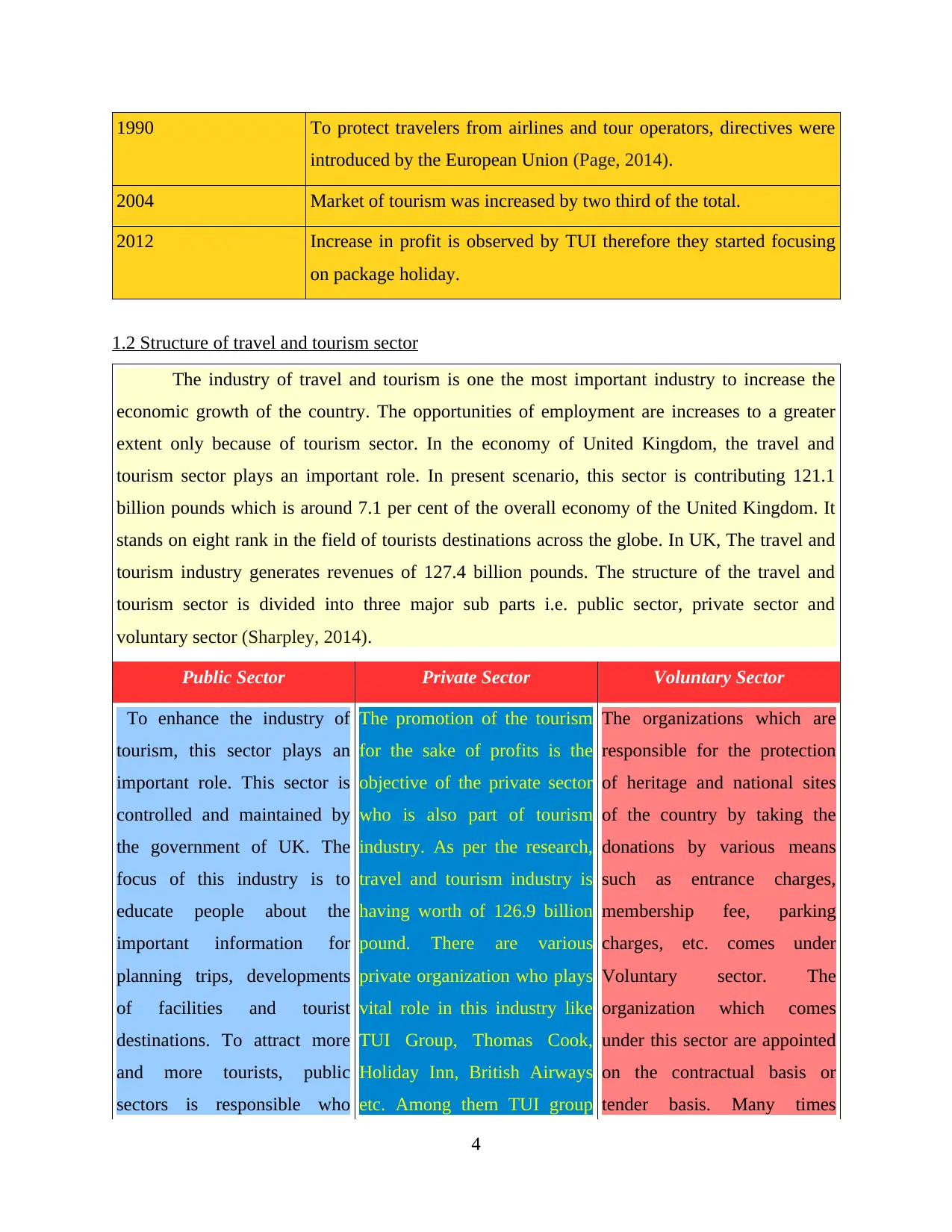
1990 To protect travelers from airlines and tour operators, directives were
introduced by the European Union (Page, 2014).
2004 Market of tourism was increased by two third of the total.
2012 Increase in profit is observed by TUI therefore they started focusing
on package holiday.
1.2 Structure of travel and tourism sector
The industry of travel and tourism is one the most important industry to increase the
economic growth of the country. The opportunities of employment are increases to a greater
extent only because of tourism sector. In the economy of United Kingdom, the travel and
tourism sector plays an important role. In present scenario, this sector is contributing 121.1
billion pounds which is around 7.1 per cent of the overall economy of the United Kingdom. It
stands on eight rank in the field of tourists destinations across the globe. In UK, The travel and
tourism industry generates revenues of 127.4 billion pounds. The structure of the travel and
tourism sector is divided into three major sub parts i.e. public sector, private sector and
voluntary sector (Sharpley, 2014).
Public Sector Private Sector Voluntary Sector
To enhance the industry of
tourism, this sector plays an
important role. This sector is
controlled and maintained by
the government of UK. The
focus of this industry is to
educate people about the
important information for
planning trips, developments
of facilities and tourist
destinations. To attract more
and more tourists, public
sectors is responsible who
The promotion of the tourism
for the sake of profits is the
objective of the private sector
who is also part of tourism
industry. As per the research,
travel and tourism industry is
having worth of 126.9 billion
pound. There are various
private organization who plays
vital role in this industry like
TUI Group, Thomas Cook,
Holiday Inn, British Airways
etc. Among them TUI group
The organizations which are
responsible for the protection
of heritage and national sites
of the country by taking the
donations by various means
such as entrance charges,
membership fee, parking
charges, etc. comes under
Voluntary sector. The
organization which comes
under this sector are appointed
on the contractual basis or
tender basis. Many times
4
introduced by the European Union (Page, 2014).
2004 Market of tourism was increased by two third of the total.
2012 Increase in profit is observed by TUI therefore they started focusing
on package holiday.
1.2 Structure of travel and tourism sector
The industry of travel and tourism is one the most important industry to increase the
economic growth of the country. The opportunities of employment are increases to a greater
extent only because of tourism sector. In the economy of United Kingdom, the travel and
tourism sector plays an important role. In present scenario, this sector is contributing 121.1
billion pounds which is around 7.1 per cent of the overall economy of the United Kingdom. It
stands on eight rank in the field of tourists destinations across the globe. In UK, The travel and
tourism industry generates revenues of 127.4 billion pounds. The structure of the travel and
tourism sector is divided into three major sub parts i.e. public sector, private sector and
voluntary sector (Sharpley, 2014).
Public Sector Private Sector Voluntary Sector
To enhance the industry of
tourism, this sector plays an
important role. This sector is
controlled and maintained by
the government of UK. The
focus of this industry is to
educate people about the
important information for
planning trips, developments
of facilities and tourist
destinations. To attract more
and more tourists, public
sectors is responsible who
The promotion of the tourism
for the sake of profits is the
objective of the private sector
who is also part of tourism
industry. As per the research,
travel and tourism industry is
having worth of 126.9 billion
pound. There are various
private organization who plays
vital role in this industry like
TUI Group, Thomas Cook,
Holiday Inn, British Airways
etc. Among them TUI group
The organizations which are
responsible for the protection
of heritage and national sites
of the country by taking the
donations by various means
such as entrance charges,
membership fee, parking
charges, etc. comes under
Voluntary sector. The
organization which comes
under this sector are appointed
on the contractual basis or
tender basis. Many times
4
⊘ This is a preview!⊘
Do you want full access?
Subscribe today to unlock all pages.

Trusted by 1+ million students worldwide
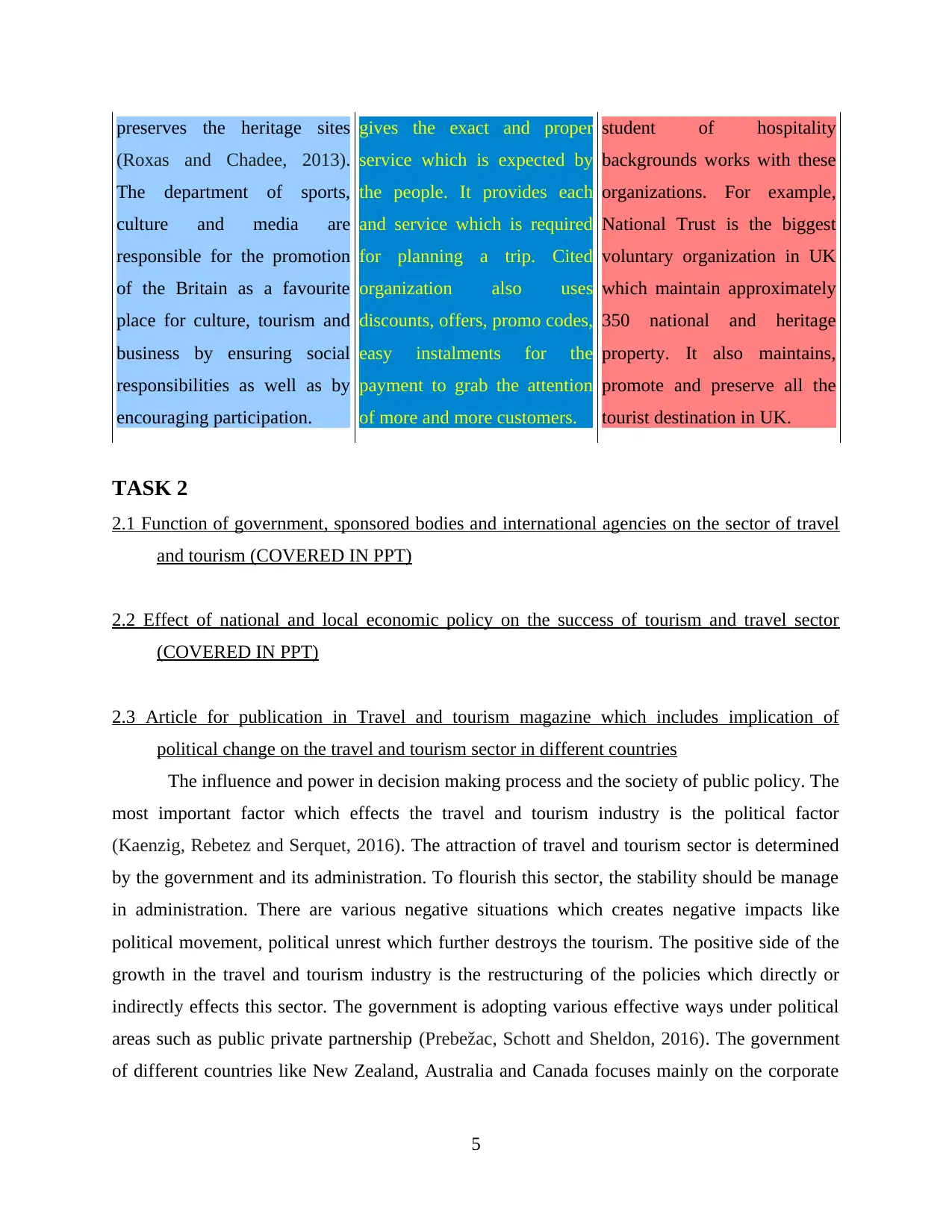
preserves the heritage sites
(Roxas and Chadee, 2013).
The department of sports,
culture and media are
responsible for the promotion
of the Britain as a favourite
place for culture, tourism and
business by ensuring social
responsibilities as well as by
encouraging participation.
gives the exact and proper
service which is expected by
the people. It provides each
and service which is required
for planning a trip. Cited
organization also uses
discounts, offers, promo codes,
easy instalments for the
payment to grab the attention
of more and more customers.
student of hospitality
backgrounds works with these
organizations. For example,
National Trust is the biggest
voluntary organization in UK
which maintain approximately
350 national and heritage
property. It also maintains,
promote and preserve all the
tourist destination in UK.
TASK 2
2.1 Function of government, sponsored bodies and international agencies on the sector of travel
and tourism (COVERED IN PPT)
2.2 Effect of national and local economic policy on the success of tourism and travel sector
(COVERED IN PPT)
2.3 Article for publication in Travel and tourism magazine which includes implication of
political change on the travel and tourism sector in different countries
The influence and power in decision making process and the society of public policy. The
most important factor which effects the travel and tourism industry is the political factor
(Kaenzig, Rebetez and Serquet, 2016). The attraction of travel and tourism sector is determined
by the government and its administration. To flourish this sector, the stability should be manage
in administration. There are various negative situations which creates negative impacts like
political movement, political unrest which further destroys the tourism. The positive side of the
growth in the travel and tourism industry is the restructuring of the policies which directly or
indirectly effects this sector. The government is adopting various effective ways under political
areas such as public private partnership (Prebežac, Schott and Sheldon, 2016). The government
of different countries like New Zealand, Australia and Canada focuses mainly on the corporate
5
(Roxas and Chadee, 2013).
The department of sports,
culture and media are
responsible for the promotion
of the Britain as a favourite
place for culture, tourism and
business by ensuring social
responsibilities as well as by
encouraging participation.
gives the exact and proper
service which is expected by
the people. It provides each
and service which is required
for planning a trip. Cited
organization also uses
discounts, offers, promo codes,
easy instalments for the
payment to grab the attention
of more and more customers.
student of hospitality
backgrounds works with these
organizations. For example,
National Trust is the biggest
voluntary organization in UK
which maintain approximately
350 national and heritage
property. It also maintains,
promote and preserve all the
tourist destination in UK.
TASK 2
2.1 Function of government, sponsored bodies and international agencies on the sector of travel
and tourism (COVERED IN PPT)
2.2 Effect of national and local economic policy on the success of tourism and travel sector
(COVERED IN PPT)
2.3 Article for publication in Travel and tourism magazine which includes implication of
political change on the travel and tourism sector in different countries
The influence and power in decision making process and the society of public policy. The
most important factor which effects the travel and tourism industry is the political factor
(Kaenzig, Rebetez and Serquet, 2016). The attraction of travel and tourism sector is determined
by the government and its administration. To flourish this sector, the stability should be manage
in administration. There are various negative situations which creates negative impacts like
political movement, political unrest which further destroys the tourism. The positive side of the
growth in the travel and tourism industry is the restructuring of the policies which directly or
indirectly effects this sector. The government is adopting various effective ways under political
areas such as public private partnership (Prebežac, Schott and Sheldon, 2016). The government
of different countries like New Zealand, Australia and Canada focuses mainly on the corporate
5
Paraphrase This Document
Need a fresh take? Get an instant paraphrase of this document with our AI Paraphraser
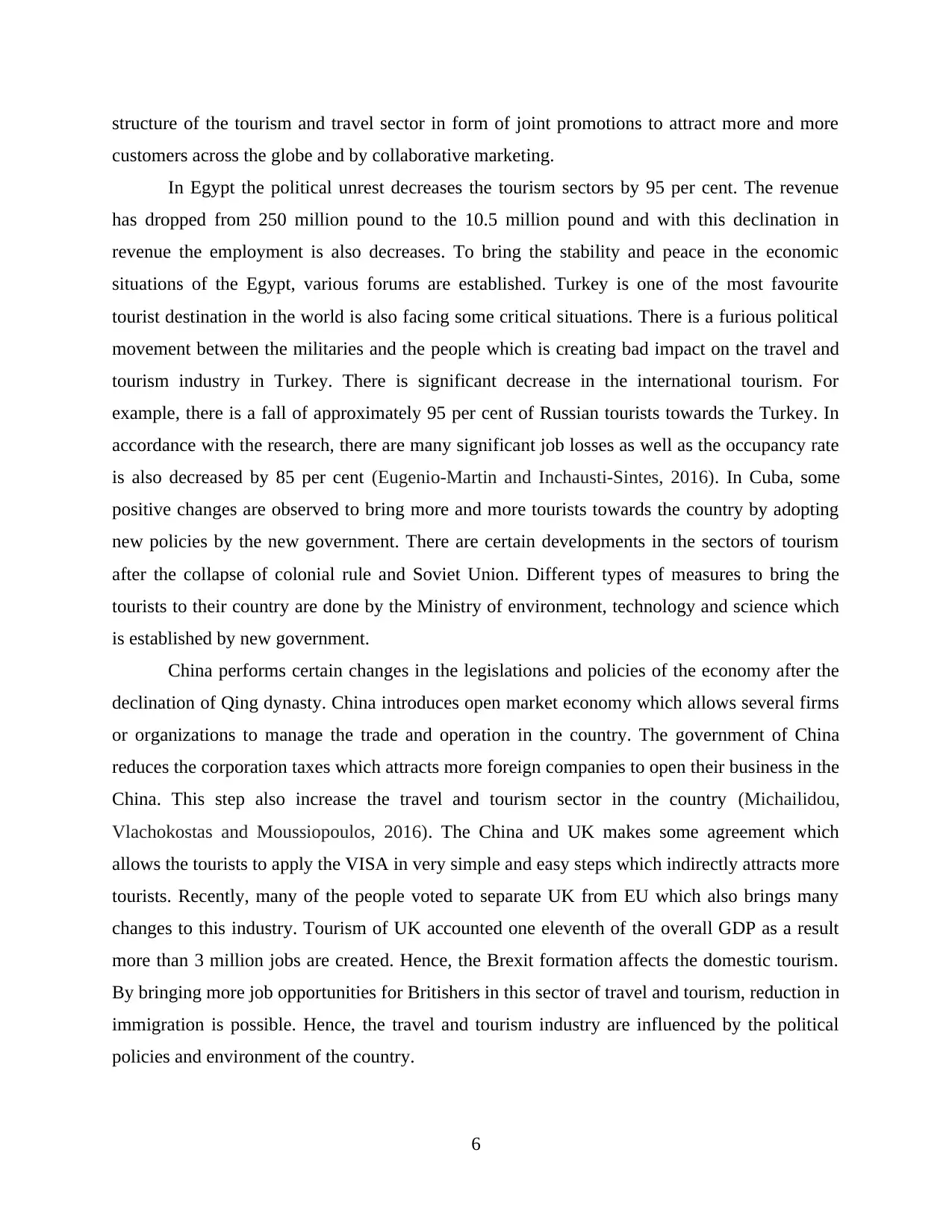
structure of the tourism and travel sector in form of joint promotions to attract more and more
customers across the globe and by collaborative marketing.
In Egypt the political unrest decreases the tourism sectors by 95 per cent. The revenue
has dropped from 250 million pound to the 10.5 million pound and with this declination in
revenue the employment is also decreases. To bring the stability and peace in the economic
situations of the Egypt, various forums are established. Turkey is one of the most favourite
tourist destination in the world is also facing some critical situations. There is a furious political
movement between the militaries and the people which is creating bad impact on the travel and
tourism industry in Turkey. There is significant decrease in the international tourism. For
example, there is a fall of approximately 95 per cent of Russian tourists towards the Turkey. In
accordance with the research, there are many significant job losses as well as the occupancy rate
is also decreased by 85 per cent (Eugenio-Martin and Inchausti-Sintes, 2016). In Cuba, some
positive changes are observed to bring more and more tourists towards the country by adopting
new policies by the new government. There are certain developments in the sectors of tourism
after the collapse of colonial rule and Soviet Union. Different types of measures to bring the
tourists to their country are done by the Ministry of environment, technology and science which
is established by new government.
China performs certain changes in the legislations and policies of the economy after the
declination of Qing dynasty. China introduces open market economy which allows several firms
or organizations to manage the trade and operation in the country. The government of China
reduces the corporation taxes which attracts more foreign companies to open their business in the
China. This step also increase the travel and tourism sector in the country (Michailidou,
Vlachokostas and Moussiopoulos, 2016). The China and UK makes some agreement which
allows the tourists to apply the VISA in very simple and easy steps which indirectly attracts more
tourists. Recently, many of the people voted to separate UK from EU which also brings many
changes to this industry. Tourism of UK accounted one eleventh of the overall GDP as a result
more than 3 million jobs are created. Hence, the Brexit formation affects the domestic tourism.
By bringing more job opportunities for Britishers in this sector of travel and tourism, reduction in
immigration is possible. Hence, the travel and tourism industry are influenced by the political
policies and environment of the country.
6
customers across the globe and by collaborative marketing.
In Egypt the political unrest decreases the tourism sectors by 95 per cent. The revenue
has dropped from 250 million pound to the 10.5 million pound and with this declination in
revenue the employment is also decreases. To bring the stability and peace in the economic
situations of the Egypt, various forums are established. Turkey is one of the most favourite
tourist destination in the world is also facing some critical situations. There is a furious political
movement between the militaries and the people which is creating bad impact on the travel and
tourism industry in Turkey. There is significant decrease in the international tourism. For
example, there is a fall of approximately 95 per cent of Russian tourists towards the Turkey. In
accordance with the research, there are many significant job losses as well as the occupancy rate
is also decreased by 85 per cent (Eugenio-Martin and Inchausti-Sintes, 2016). In Cuba, some
positive changes are observed to bring more and more tourists towards the country by adopting
new policies by the new government. There are certain developments in the sectors of tourism
after the collapse of colonial rule and Soviet Union. Different types of measures to bring the
tourists to their country are done by the Ministry of environment, technology and science which
is established by new government.
China performs certain changes in the legislations and policies of the economy after the
declination of Qing dynasty. China introduces open market economy which allows several firms
or organizations to manage the trade and operation in the country. The government of China
reduces the corporation taxes which attracts more foreign companies to open their business in the
China. This step also increase the travel and tourism sector in the country (Michailidou,
Vlachokostas and Moussiopoulos, 2016). The China and UK makes some agreement which
allows the tourists to apply the VISA in very simple and easy steps which indirectly attracts more
tourists. Recently, many of the people voted to separate UK from EU which also brings many
changes to this industry. Tourism of UK accounted one eleventh of the overall GDP as a result
more than 3 million jobs are created. Hence, the Brexit formation affects the domestic tourism.
By bringing more job opportunities for Britishers in this sector of travel and tourism, reduction in
immigration is possible. Hence, the travel and tourism industry are influenced by the political
policies and environment of the country.
6
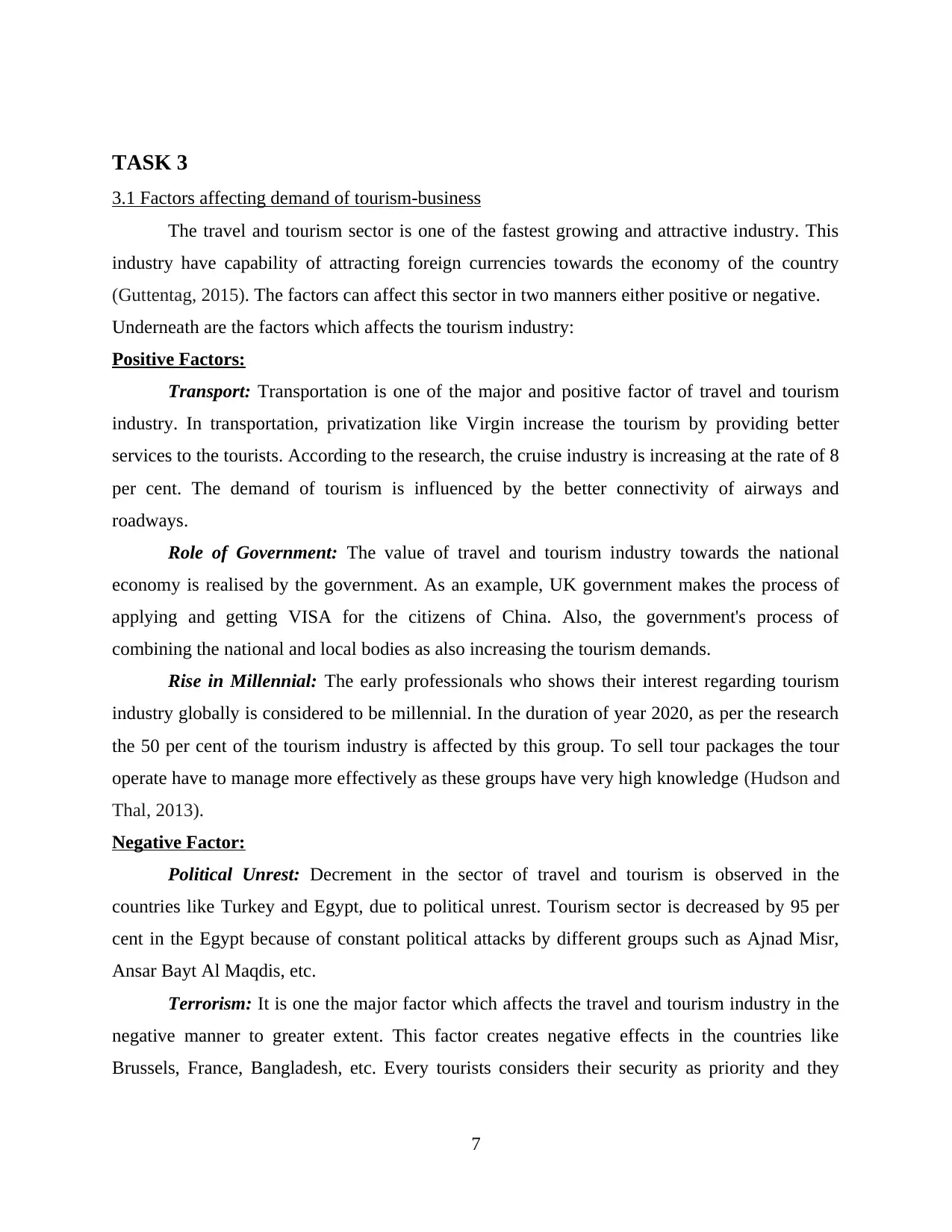
TASK 3
3.1 Factors affecting demand of tourism-business
The travel and tourism sector is one of the fastest growing and attractive industry. This
industry have capability of attracting foreign currencies towards the economy of the country
(Guttentag, 2015). The factors can affect this sector in two manners either positive or negative.
Underneath are the factors which affects the tourism industry:
Positive Factors:
Transport: Transportation is one of the major and positive factor of travel and tourism
industry. In transportation, privatization like Virgin increase the tourism by providing better
services to the tourists. According to the research, the cruise industry is increasing at the rate of 8
per cent. The demand of tourism is influenced by the better connectivity of airways and
roadways.
Role of Government: The value of travel and tourism industry towards the national
economy is realised by the government. As an example, UK government makes the process of
applying and getting VISA for the citizens of China. Also, the government's process of
combining the national and local bodies as also increasing the tourism demands.
Rise in Millennial: The early professionals who shows their interest regarding tourism
industry globally is considered to be millennial. In the duration of year 2020, as per the research
the 50 per cent of the tourism industry is affected by this group. To sell tour packages the tour
operate have to manage more effectively as these groups have very high knowledge (Hudson and
Thal, 2013).
Negative Factor:
Political Unrest: Decrement in the sector of travel and tourism is observed in the
countries like Turkey and Egypt, due to political unrest. Tourism sector is decreased by 95 per
cent in the Egypt because of constant political attacks by different groups such as Ajnad Misr,
Ansar Bayt Al Maqdis, etc.
Terrorism: It is one the major factor which affects the travel and tourism industry in the
negative manner to greater extent. This factor creates negative effects in the countries like
Brussels, France, Bangladesh, etc. Every tourists considers their security as priority and they
7
3.1 Factors affecting demand of tourism-business
The travel and tourism sector is one of the fastest growing and attractive industry. This
industry have capability of attracting foreign currencies towards the economy of the country
(Guttentag, 2015). The factors can affect this sector in two manners either positive or negative.
Underneath are the factors which affects the tourism industry:
Positive Factors:
Transport: Transportation is one of the major and positive factor of travel and tourism
industry. In transportation, privatization like Virgin increase the tourism by providing better
services to the tourists. According to the research, the cruise industry is increasing at the rate of 8
per cent. The demand of tourism is influenced by the better connectivity of airways and
roadways.
Role of Government: The value of travel and tourism industry towards the national
economy is realised by the government. As an example, UK government makes the process of
applying and getting VISA for the citizens of China. Also, the government's process of
combining the national and local bodies as also increasing the tourism demands.
Rise in Millennial: The early professionals who shows their interest regarding tourism
industry globally is considered to be millennial. In the duration of year 2020, as per the research
the 50 per cent of the tourism industry is affected by this group. To sell tour packages the tour
operate have to manage more effectively as these groups have very high knowledge (Hudson and
Thal, 2013).
Negative Factor:
Political Unrest: Decrement in the sector of travel and tourism is observed in the
countries like Turkey and Egypt, due to political unrest. Tourism sector is decreased by 95 per
cent in the Egypt because of constant political attacks by different groups such as Ajnad Misr,
Ansar Bayt Al Maqdis, etc.
Terrorism: It is one the major factor which affects the travel and tourism industry in the
negative manner to greater extent. This factor creates negative effects in the countries like
Brussels, France, Bangladesh, etc. Every tourists considers their security as priority and they
7
⊘ This is a preview!⊘
Do you want full access?
Subscribe today to unlock all pages.

Trusted by 1+ million students worldwide
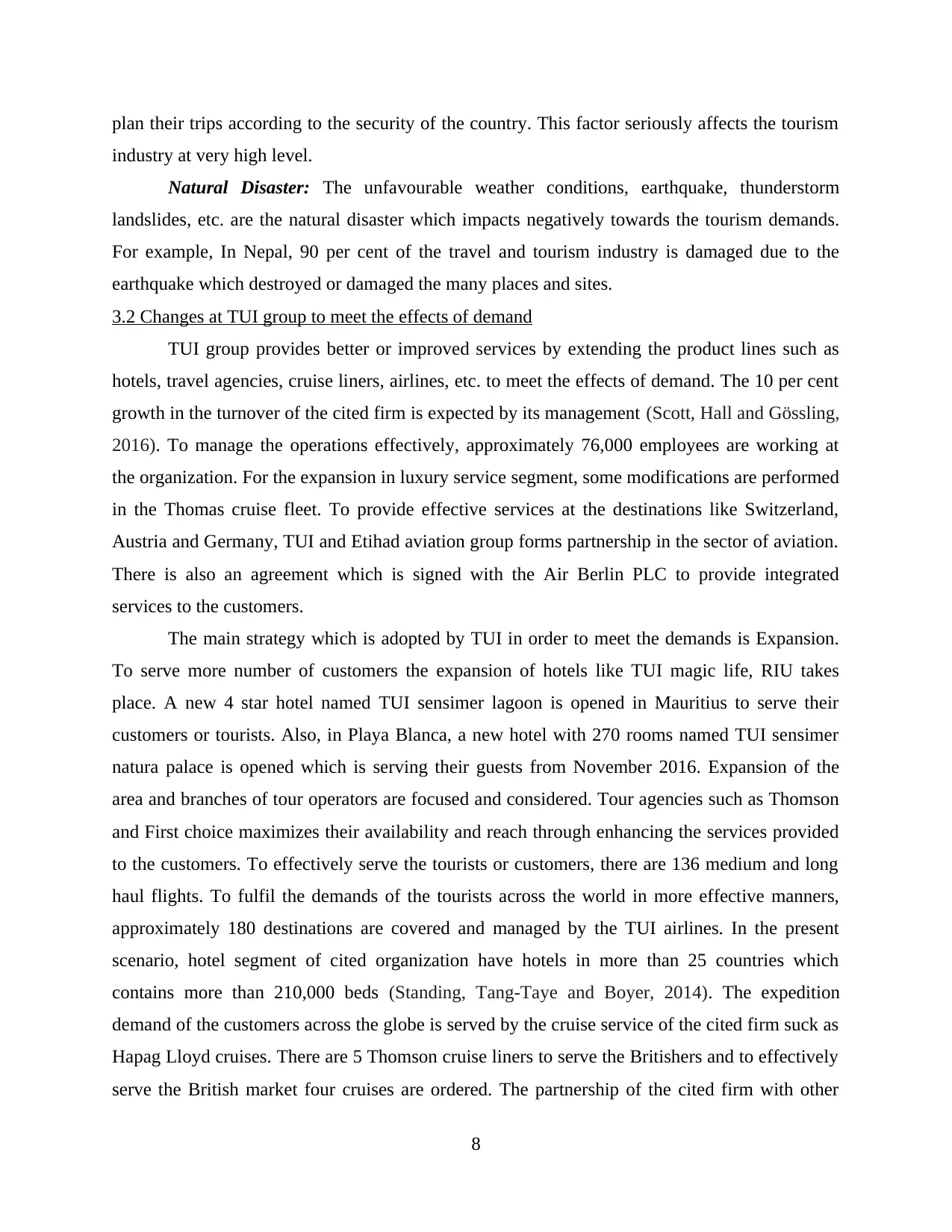
plan their trips according to the security of the country. This factor seriously affects the tourism
industry at very high level.
Natural Disaster: The unfavourable weather conditions, earthquake, thunderstorm
landslides, etc. are the natural disaster which impacts negatively towards the tourism demands.
For example, In Nepal, 90 per cent of the travel and tourism industry is damaged due to the
earthquake which destroyed or damaged the many places and sites.
3.2 Changes at TUI group to meet the effects of demand
TUI group provides better or improved services by extending the product lines such as
hotels, travel agencies, cruise liners, airlines, etc. to meet the effects of demand. The 10 per cent
growth in the turnover of the cited firm is expected by its management (Scott, Hall and Gössling,
2016). To manage the operations effectively, approximately 76,000 employees are working at
the organization. For the expansion in luxury service segment, some modifications are performed
in the Thomas cruise fleet. To provide effective services at the destinations like Switzerland,
Austria and Germany, TUI and Etihad aviation group forms partnership in the sector of aviation.
There is also an agreement which is signed with the Air Berlin PLC to provide integrated
services to the customers.
The main strategy which is adopted by TUI in order to meet the demands is Expansion.
To serve more number of customers the expansion of hotels like TUI magic life, RIU takes
place. A new 4 star hotel named TUI sensimer lagoon is opened in Mauritius to serve their
customers or tourists. Also, in Playa Blanca, a new hotel with 270 rooms named TUI sensimer
natura palace is opened which is serving their guests from November 2016. Expansion of the
area and branches of tour operators are focused and considered. Tour agencies such as Thomson
and First choice maximizes their availability and reach through enhancing the services provided
to the customers. To effectively serve the tourists or customers, there are 136 medium and long
haul flights. To fulfil the demands of the tourists across the world in more effective manners,
approximately 180 destinations are covered and managed by the TUI airlines. In the present
scenario, hotel segment of cited organization have hotels in more than 25 countries which
contains more than 210,000 beds (Standing, Tang-Taye and Boyer, 2014). The expedition
demand of the customers across the globe is served by the cruise service of the cited firm suck as
Hapag Lloyd cruises. There are 5 Thomson cruise liners to serve the Britishers and to effectively
serve the British market four cruises are ordered. The partnership of the cited firm with other
8
industry at very high level.
Natural Disaster: The unfavourable weather conditions, earthquake, thunderstorm
landslides, etc. are the natural disaster which impacts negatively towards the tourism demands.
For example, In Nepal, 90 per cent of the travel and tourism industry is damaged due to the
earthquake which destroyed or damaged the many places and sites.
3.2 Changes at TUI group to meet the effects of demand
TUI group provides better or improved services by extending the product lines such as
hotels, travel agencies, cruise liners, airlines, etc. to meet the effects of demand. The 10 per cent
growth in the turnover of the cited firm is expected by its management (Scott, Hall and Gössling,
2016). To manage the operations effectively, approximately 76,000 employees are working at
the organization. For the expansion in luxury service segment, some modifications are performed
in the Thomas cruise fleet. To provide effective services at the destinations like Switzerland,
Austria and Germany, TUI and Etihad aviation group forms partnership in the sector of aviation.
There is also an agreement which is signed with the Air Berlin PLC to provide integrated
services to the customers.
The main strategy which is adopted by TUI in order to meet the demands is Expansion.
To serve more number of customers the expansion of hotels like TUI magic life, RIU takes
place. A new 4 star hotel named TUI sensimer lagoon is opened in Mauritius to serve their
customers or tourists. Also, in Playa Blanca, a new hotel with 270 rooms named TUI sensimer
natura palace is opened which is serving their guests from November 2016. Expansion of the
area and branches of tour operators are focused and considered. Tour agencies such as Thomson
and First choice maximizes their availability and reach through enhancing the services provided
to the customers. To effectively serve the tourists or customers, there are 136 medium and long
haul flights. To fulfil the demands of the tourists across the world in more effective manners,
approximately 180 destinations are covered and managed by the TUI airlines. In the present
scenario, hotel segment of cited organization have hotels in more than 25 countries which
contains more than 210,000 beds (Standing, Tang-Taye and Boyer, 2014). The expedition
demand of the customers across the globe is served by the cruise service of the cited firm suck as
Hapag Lloyd cruises. There are 5 Thomson cruise liners to serve the Britishers and to effectively
serve the British market four cruises are ordered. The partnership of the cited firm with other
8
Paraphrase This Document
Need a fresh take? Get an instant paraphrase of this document with our AI Paraphraser
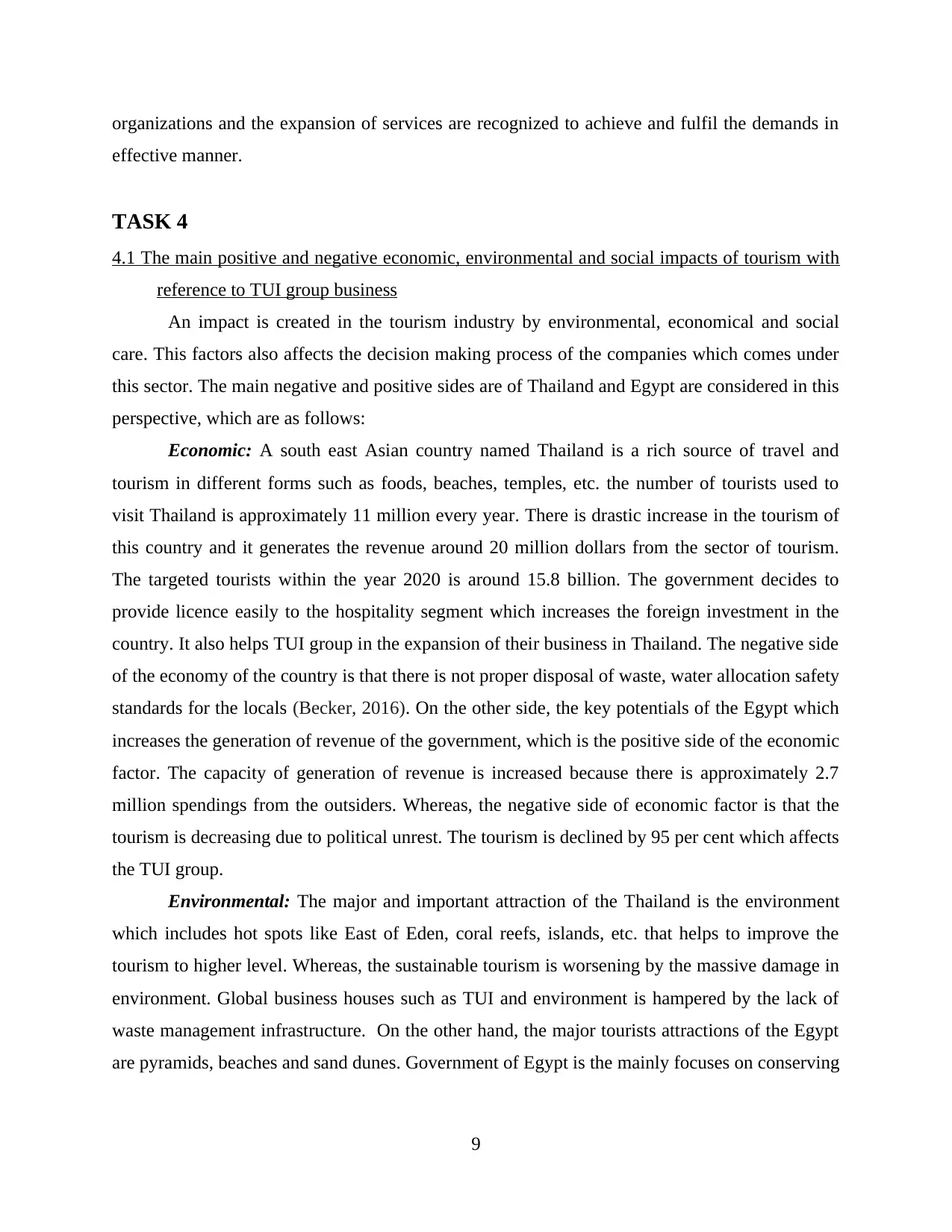
organizations and the expansion of services are recognized to achieve and fulfil the demands in
effective manner.
TASK 4
4.1 The main positive and negative economic, environmental and social impacts of tourism with
reference to TUI group business
An impact is created in the tourism industry by environmental, economical and social
care. This factors also affects the decision making process of the companies which comes under
this sector. The main negative and positive sides are of Thailand and Egypt are considered in this
perspective, which are as follows:
Economic: A south east Asian country named Thailand is a rich source of travel and
tourism in different forms such as foods, beaches, temples, etc. the number of tourists used to
visit Thailand is approximately 11 million every year. There is drastic increase in the tourism of
this country and it generates the revenue around 20 million dollars from the sector of tourism.
The targeted tourists within the year 2020 is around 15.8 billion. The government decides to
provide licence easily to the hospitality segment which increases the foreign investment in the
country. It also helps TUI group in the expansion of their business in Thailand. The negative side
of the economy of the country is that there is not proper disposal of waste, water allocation safety
standards for the locals (Becker, 2016). On the other side, the key potentials of the Egypt which
increases the generation of revenue of the government, which is the positive side of the economic
factor. The capacity of generation of revenue is increased because there is approximately 2.7
million spendings from the outsiders. Whereas, the negative side of economic factor is that the
tourism is decreasing due to political unrest. The tourism is declined by 95 per cent which affects
the TUI group.
Environmental: The major and important attraction of the Thailand is the environment
which includes hot spots like East of Eden, coral reefs, islands, etc. that helps to improve the
tourism to higher level. Whereas, the sustainable tourism is worsening by the massive damage in
environment. Global business houses such as TUI and environment is hampered by the lack of
waste management infrastructure. On the other hand, the major tourists attractions of the Egypt
are pyramids, beaches and sand dunes. Government of Egypt is the mainly focuses on conserving
9
effective manner.
TASK 4
4.1 The main positive and negative economic, environmental and social impacts of tourism with
reference to TUI group business
An impact is created in the tourism industry by environmental, economical and social
care. This factors also affects the decision making process of the companies which comes under
this sector. The main negative and positive sides are of Thailand and Egypt are considered in this
perspective, which are as follows:
Economic: A south east Asian country named Thailand is a rich source of travel and
tourism in different forms such as foods, beaches, temples, etc. the number of tourists used to
visit Thailand is approximately 11 million every year. There is drastic increase in the tourism of
this country and it generates the revenue around 20 million dollars from the sector of tourism.
The targeted tourists within the year 2020 is around 15.8 billion. The government decides to
provide licence easily to the hospitality segment which increases the foreign investment in the
country. It also helps TUI group in the expansion of their business in Thailand. The negative side
of the economy of the country is that there is not proper disposal of waste, water allocation safety
standards for the locals (Becker, 2016). On the other side, the key potentials of the Egypt which
increases the generation of revenue of the government, which is the positive side of the economic
factor. The capacity of generation of revenue is increased because there is approximately 2.7
million spendings from the outsiders. Whereas, the negative side of economic factor is that the
tourism is decreasing due to political unrest. The tourism is declined by 95 per cent which affects
the TUI group.
Environmental: The major and important attraction of the Thailand is the environment
which includes hot spots like East of Eden, coral reefs, islands, etc. that helps to improve the
tourism to higher level. Whereas, the sustainable tourism is worsening by the massive damage in
environment. Global business houses such as TUI and environment is hampered by the lack of
waste management infrastructure. On the other hand, the major tourists attractions of the Egypt
are pyramids, beaches and sand dunes. Government of Egypt is the mainly focuses on conserving
9
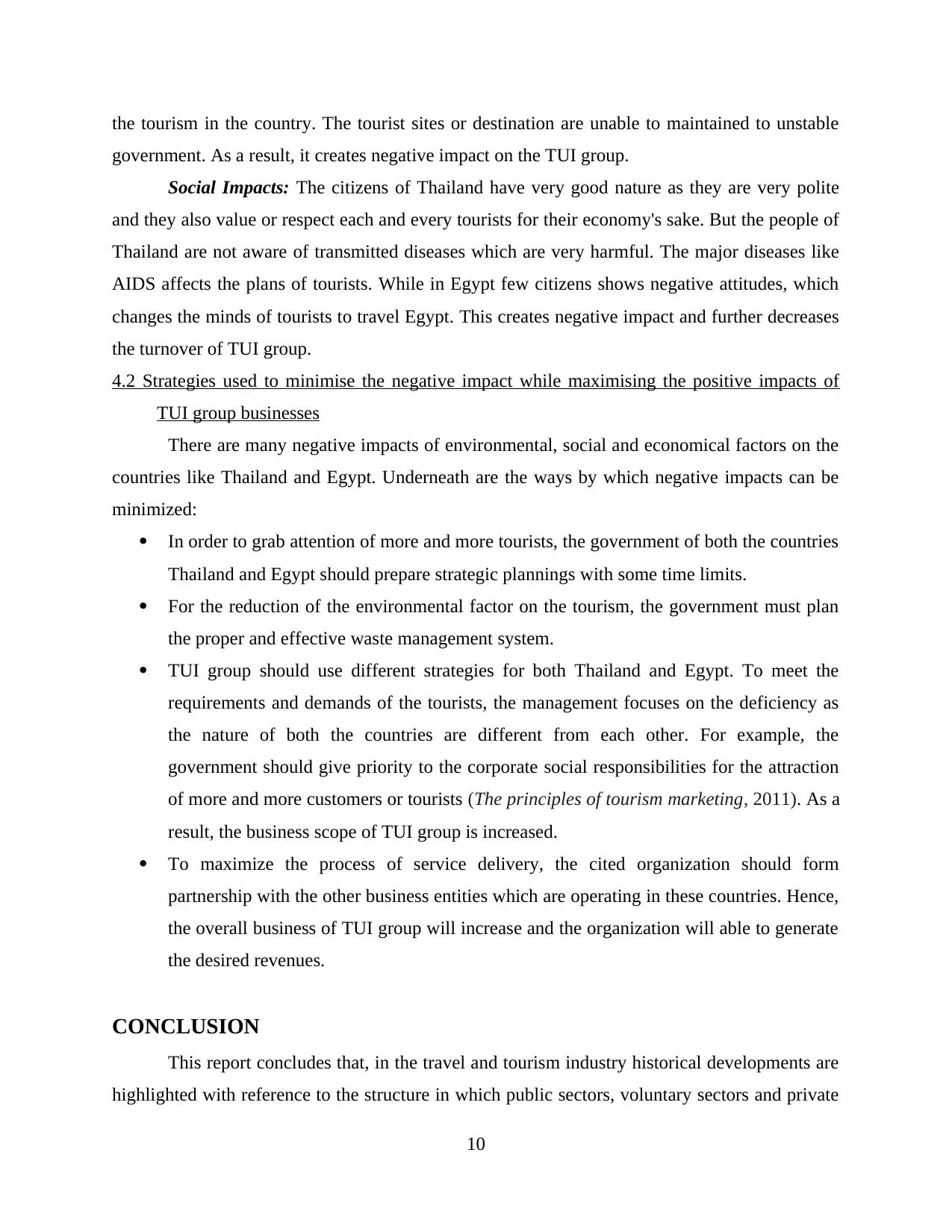
the tourism in the country. The tourist sites or destination are unable to maintained to unstable
government. As a result, it creates negative impact on the TUI group.
Social Impacts: The citizens of Thailand have very good nature as they are very polite
and they also value or respect each and every tourists for their economy's sake. But the people of
Thailand are not aware of transmitted diseases which are very harmful. The major diseases like
AIDS affects the plans of tourists. While in Egypt few citizens shows negative attitudes, which
changes the minds of tourists to travel Egypt. This creates negative impact and further decreases
the turnover of TUI group.
4.2 Strategies used to minimise the negative impact while maximising the positive impacts of
TUI group businesses
There are many negative impacts of environmental, social and economical factors on the
countries like Thailand and Egypt. Underneath are the ways by which negative impacts can be
minimized:
In order to grab attention of more and more tourists, the government of both the countries
Thailand and Egypt should prepare strategic plannings with some time limits.
For the reduction of the environmental factor on the tourism, the government must plan
the proper and effective waste management system.
TUI group should use different strategies for both Thailand and Egypt. To meet the
requirements and demands of the tourists, the management focuses on the deficiency as
the nature of both the countries are different from each other. For example, the
government should give priority to the corporate social responsibilities for the attraction
of more and more customers or tourists (The principles of tourism marketing, 2011). As a
result, the business scope of TUI group is increased.
To maximize the process of service delivery, the cited organization should form
partnership with the other business entities which are operating in these countries. Hence,
the overall business of TUI group will increase and the organization will able to generate
the desired revenues.
CONCLUSION
This report concludes that, in the travel and tourism industry historical developments are
highlighted with reference to the structure in which public sectors, voluntary sectors and private
10
government. As a result, it creates negative impact on the TUI group.
Social Impacts: The citizens of Thailand have very good nature as they are very polite
and they also value or respect each and every tourists for their economy's sake. But the people of
Thailand are not aware of transmitted diseases which are very harmful. The major diseases like
AIDS affects the plans of tourists. While in Egypt few citizens shows negative attitudes, which
changes the minds of tourists to travel Egypt. This creates negative impact and further decreases
the turnover of TUI group.
4.2 Strategies used to minimise the negative impact while maximising the positive impacts of
TUI group businesses
There are many negative impacts of environmental, social and economical factors on the
countries like Thailand and Egypt. Underneath are the ways by which negative impacts can be
minimized:
In order to grab attention of more and more tourists, the government of both the countries
Thailand and Egypt should prepare strategic plannings with some time limits.
For the reduction of the environmental factor on the tourism, the government must plan
the proper and effective waste management system.
TUI group should use different strategies for both Thailand and Egypt. To meet the
requirements and demands of the tourists, the management focuses on the deficiency as
the nature of both the countries are different from each other. For example, the
government should give priority to the corporate social responsibilities for the attraction
of more and more customers or tourists (The principles of tourism marketing, 2011). As a
result, the business scope of TUI group is increased.
To maximize the process of service delivery, the cited organization should form
partnership with the other business entities which are operating in these countries. Hence,
the overall business of TUI group will increase and the organization will able to generate
the desired revenues.
CONCLUSION
This report concludes that, in the travel and tourism industry historical developments are
highlighted with reference to the structure in which public sectors, voluntary sectors and private
10
⊘ This is a preview!⊘
Do you want full access?
Subscribe today to unlock all pages.

Trusted by 1+ million students worldwide
1 out of 16
Related Documents
Your All-in-One AI-Powered Toolkit for Academic Success.
+13062052269
info@desklib.com
Available 24*7 on WhatsApp / Email
![[object Object]](/_next/static/media/star-bottom.7253800d.svg)
Unlock your academic potential
Copyright © 2020–2025 A2Z Services. All Rights Reserved. Developed and managed by ZUCOL.





